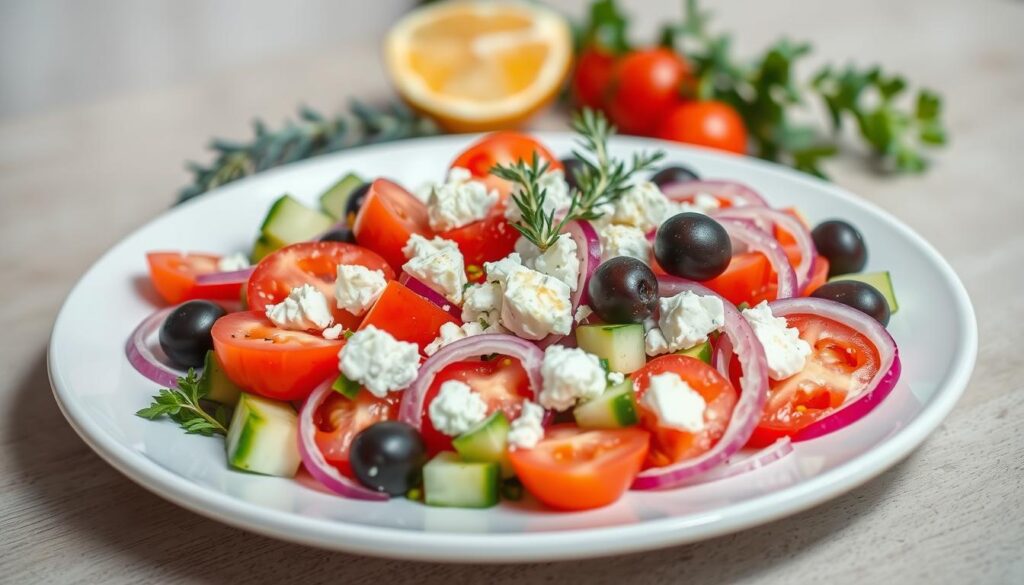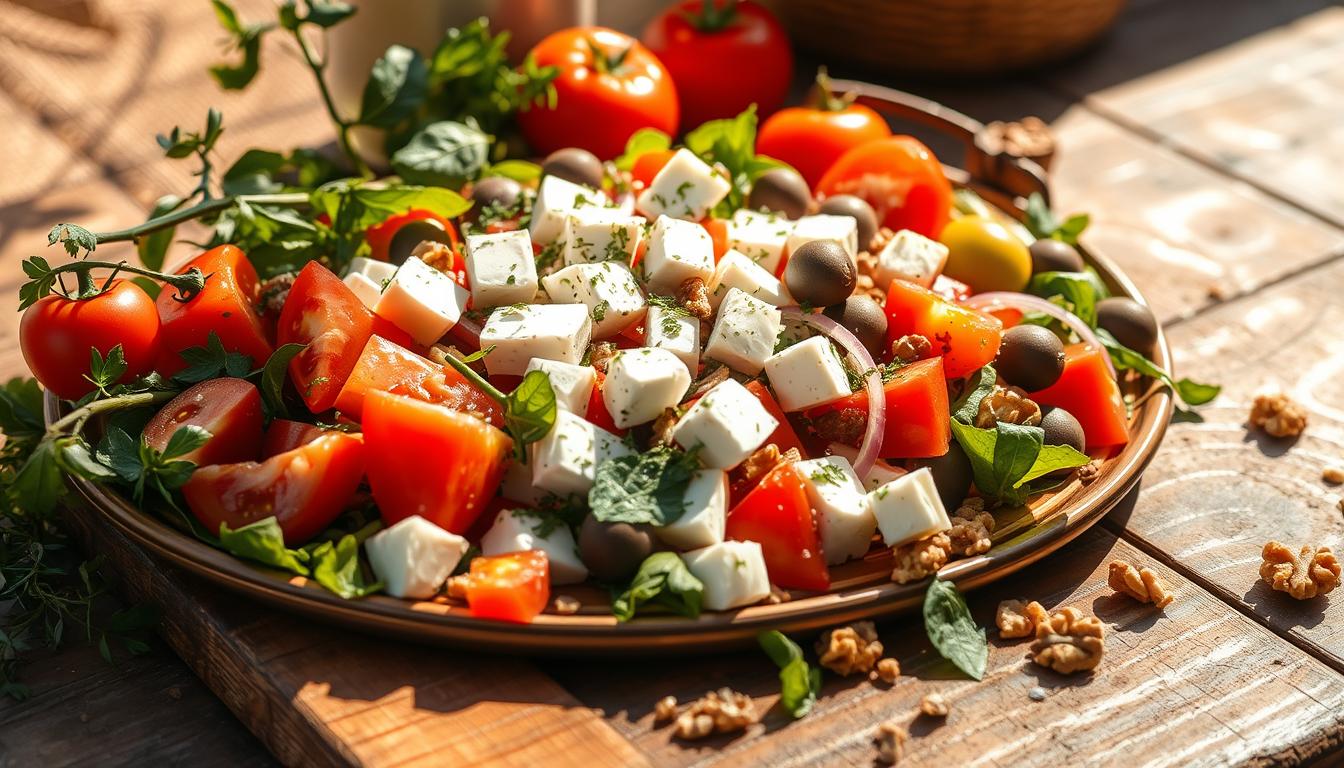Did you know the traditional Authentic Greek Salad Horiatiki, is more than veggies and feta? It shows Greek cuisine’s love for simplicity and fresh ingredients.
Exploring this classic recipe, you’ll find a mix of flavors and textures. This dish is a big part of Greek culture. This article will help you make Horiatiki at home, with tips to get it just right.
Key Takeaways
- Learn the traditional ingredients of an authentic greek salad
- Understand the significance of Horiatiki in Greek cuisine
- Discover simple tips to prepare a classic greek salad recipe
- Explore the cultural context behind this beloved dish
- Recreate Horiatiki with ease using our step-by-step guide
The Origins of Greek Salad
Did you know the Greek salad, or Horiatiki, comes from Greek culture? It’s a traditional Mediterranean salad that shows the simplicity and richness of Greek food.
A Brief History of Horiatiki
The Greek salad, known as Horiatiki, started in rural Greece. The name “Horiatiki” means “of the village” or “peasant salad.” It was a simple meal made with local ingredients like tomatoes, cucumbers, onions, feta cheese, and olives.
“The Greek salad is a reflection of the Greek philosophy of living in harmony with nature and making the most of what the land provides.”
Regional Variations Across Greece
Traveling through Greece, you’ll find different versions of the Greek salad. Each area adds its own touch, using local ingredients for a unique taste. For example, some places might add capers or different cheeses.
| Region | Unique Ingredient | Flavor Profile |
|---|---|---|
| Crete | Capers | Salty, tangy |
| Peloponnese | Local herbs | Fresh, aromatic |
Cultural Significance in Greek Cuisine
The Greek salad is more than food; it’s a sign of Greek hospitality and community. It’s served at family gatherings and social events, bringing people together with a tasty meal.
In conclusion, the Greek salad, or Horiatiki, is steeped in history and cultural importance. Its variations across Greece show the country’s diverse food scene. It highlights the value of community and tradition in Greek cuisine.
What Makes an Authentic Greek Salad (Horiatiki)
A genuine Greek salad, or Horiatiki, is all about simplicity and freshness. You might wonder what makes it stand out. It’s the traditional ingredients and how they’re prepared.
Traditional vs. Americanized Versions
When you think of a Greek salad, you might picture lettuce, tomatoes, cucumbers, and feta cheese. But the real Greek salad is different. It doesn’t have lettuce. Instead, it’s all about fresh veggies, tangy feta, and salty olives.
The traditional Greek salad shows off Greek cuisine’s love for simplicity and freshness. You’ll definitely notice the difference when you try it.
The No-Lettuce Rule
Lettuce isn’t a usual part of a traditional Greek salad. This is because lettuce wasn’t common in Greek food until recently. You can still enjoy a healthy Greek salad without lettuce. Focus on the flavors of tomatoes, cucumbers, red onions, and feta cheese.
Rustic Simplicity: The Essence of Horiatiki
Horiatiki’s beauty is in its rustic simplicity. Use the freshest ingredients and prepare them to bring out their natural flavors. This results in a salad that’s both healthy and tasty, capturing the essence of Greek cuisine.
When you make an authentic Greek salad, you join a long tradition. The Greek tomato cucumber salad is loved for its freshness and flavor. It shows Greece’s passion for delicious, fresh ingredients.
Essential Ingredients for the Perfect Greek Salad
The secret to a great Greek Salad lies in its core ingredients. A traditional Greek Salad, or Horiatiki, is a mix of flavors and textures. Together, they create a dish that’s more than just its parts.
Tomatoes: The Foundation
Tomatoes are the heart of a classic Greek Salad. Choose ripe, juicy tomatoes like beefsteak or heirloom. Cut them into large chunks to keep them the main focus.
Cucumbers: Crisp and Fresh
Cucumbers add a refreshing crunch. Use fresh, thinly sliced cucumbers for the right texture. Make sure to partially peel them for a nice contrast.
Red Onions: Sharp and Aromatic
Thinly sliced red onions add a pungent and sweet flavor. Use them sparingly to avoid overpowering the other ingredients.
Authentic Greek Feta: The Crown Jewel
Authentic Greek Feta is key, with its tangy, salty taste. Choose Feta made from sheep’s milk or a mix of sheep and goat’s milk for a richer taste.
Kalamata Olives: Briny Perfection
Kalamata olives are the go-to for a traditional Greek Salad. Their briny flavor and smooth texture are perfect. Remember to pit them before adding.
Green Bell Peppers: The Authentic Touch
Green bell peppers add crunch and sweetness. Slice them thinly into rings or strips for easy distribution.
Oregano and Other Herbs
Oregano is the main herb, offering a robust, earthy flavor. Adding thyme or parsley can also enhance the taste.
By focusing on these essential ingredients and their quality, you’ll make a classic Greek salad that’s both authentic and delicious.
The Art of Greek Salad Dressing
Making the perfect Greek salad dressing is an art. It takes your Mediterranean salad to new heights. The dressing brings together the salad’s flavors and textures.
Extra Virgin Olive Oil: Liquid Gold
The base of a great Greek salad dressing is extra virgin olive oil (EVOO). This “liquid gold” is full of flavor and healthy fats. Choose an EVOO that’s cold-pressed and has a rich, fruity taste.
Red Wine Vinegar: The Perfect Balance
Red wine vinegar adds a tangy, slightly sweet flavor. It balances the richness of the olive oil. Use a high-quality vinegar that’s not too harsh. Start with a 3:1 or 4:1 ratio of oil to vinegar.
Herbs and Seasonings
Fresh or dried herbs like oregano, thyme, and parsley add depth. You can also add a pinch of salt and a few grinds of black pepper. For an authentic taste, try adding a minced clove of garlic or a teaspoon of Dijon mustard.
Mixing Techniques for Perfect Flavor
To make a smooth dressing, mix the ingredients well. Use a whisk or blender for olive oil, vinegar, herbs, and seasonings. Taste and adjust the seasoning as you go. For creaminess, add Greek yogurt or Dijon mustard.
For more Mediterranean recipes and tips, visit travelwithrachael on Lemon8. There, you’ll find lots of info on making delicious, authentic dishes.
By following these tips and using quality ingredients, you can make a homemade Greek salad dressing. It will be delicious, authentic, and healthy. Experiment with different ingredients to find your perfect blend. Enjoy the rich flavors of the Mediterranean in every bite.
- Use high-quality extra virgin olive oil for the best flavor.
- Balance the dressing with red wine vinegar.
- Add fresh or dried herbs for depth of flavor.
- Mix the dressing well to emulsify the ingredients.
- Taste and adjust the seasoning as needed.
Step-by-Step Greek Salad Recipe
Making a classic Greek salad is all about using fresh ingredients and simple steps. To make a real Greek Salad, or Horiatiki, focus on the ingredients’ freshness and the easy preparation.
Ingredient Measurements and Proportions
For a traditional Greek Salad for four, you’ll need:
- 4 large tomatoes, diced
- 2 cucumbers, peeled and sliced
- 1 large red onion, thinly sliced
- 1 block of authentic Greek Feta, crumbled
- 1 cup of Kalamata olives
- 1 large green bell pepper, sliced
- A handful of fresh oregano leaves
For the dressing, mix 1/4 cup of extra virgin olive oil with 2 tablespoons of red wine vinegar. Add a pinch of salt and a few grinds of black pepper to taste.
Preparation Techniques
Begin by preparing your ingredients. Cut the tomatoes into large pieces, slice the cucumbers, and thinly slice the red onion. Crumble the Feta into generous pieces and pit the Kalamata olives. Slice the green bell pepper into rings.
Assembly Instructions
In a large, shallow bowl, combine the prepared tomatoes, cucumbers, red onions, Feta, olives, and green bell pepper. Drizzle the olive oil and red wine vinegar dressing over the salad. Sprinkle fresh oregano leaves on top.
Final Touches and Presentation
Garnish with additional oregano if desired, and serve immediately. For a rustic look, serve in a wooden bowl or on a decorative platter. You can find inspiration for other salads, like a chicken salad, to mix up your meals.
By following these steps, you’ll make a delicious and authentic Greek Salad. It will truly capture the essence of traditional Greek cuisine.
Chef’s Tips for an Exceptional Horiatiki
The secret to a truly authentic Greek salad is in the freshness and how you prepare it. To make your Horiatiki stand out, focus on a few key areas. These will greatly improve the flavor and texture.

Choosing the Ripest Produce
For an exceptional Horiatiki, choose the freshest produce. For a healthy Greek salad, pick tomatoes that are firm but give a bit when pressed. Cucumbers should be crisp and without soft spots. The quality of your ingredients greatly affects the salad’s taste and texture.
Proper Cutting Techniques
How you cut your vegetables is important. Cutting tomatoes and cucumbers into large chunks keeps their texture. Red onions should be thinly sliced to balance their sharpness with the other ingredients.
Temperature Considerations
Serving your Horiatiki at the right temperature is crucial. All ingredients should be at room temperature. This allows the flavors to blend well. It’s especially important for the feta cheese, which should be soft and creamy, not cold.
Balancing Flavors and Textures
Getting the right balance of flavors and textures is key. You want salty feta, tangy olives, sweet tomatoes, and crisp cucumbers. The dressing should enhance these without overpowering them. This balance makes the salad refreshing and satisfying.
By following these tips, you can make an amazing Horiatiki that highlights Greek cuisine. Remember, the secret to a great authentic Greek salad is in the details. It’s all about the freshness of your ingredients and how you prepare them.
Common Mistakes to Avoid When Making Greek Salad
Making a true Greek Salad needs careful attention to avoid common mistakes. A traditional Greek Salad, or Horiatiki, is more than just vegetables and feta. It’s a mix of flavors and textures that, when done right, is truly delightful.
Over-Dressing Your Salad
One big mistake is over-dressing the salad. The dressing should boost the flavors of the vegetables and feta, not drown them. Start with a small amount of dressing and add more if needed. It’s easier to add more than it is to take it away.
Using the Wrong Type of Feta
Choosing the wrong feta can change the taste and authenticity of your salad. Real Greek feta is made from sheep’s milk or a mix of sheep and goat’s milk. It has a tangy taste and crumbly texture that’s key to the salad. Don’t use feta made from cow’s milk, as it’s not as rich or tangy.
Improper Vegetable Preparation
Bad vegetable preparation can also ruin the salad. Cut the vegetables into big, chunky pieces, not small ones. This makes the salad better in texture and looks. Make sure your tomatoes are ripe, cucumbers are crisp, and red onions are thinly sliced for the best taste and texture.
Seasoning Errors
Seasoning mistakes can also mess up a good Greek Salad. The goal is to balance the flavors without overpowering the natural taste of the ingredients. Use herbs like oregano carefully and be careful with salt, especially if your feta is salty. A little seasoning at a time and tasting as you go will help you get it just right.
Regional and Modern Variations
Exploring Greek Salad reveals many regional twists on the classic. The traditional classic Greek salad is a beloved dish in Greece. But, different areas and chefs have made their own versions.
Island-Style Greek Salads
In the Greek islands, salads have unique touches. Some add capers or sun-dried tomatoes to their mediterranean salad. These changes reflect the islands’ local tastes and traditions, making each salad special.

Contemporary Twists
Modern chefs and cooks are making the Greek Salad their own. They add things like grilled octopus or quinoa. This mix of old and new flavors is exciting.
Seasonal Adaptations
Seasonal changes also influence the Greek Salad. Using fresh, seasonal ingredients makes the salad vibrant and tasty. For example, summer salads might feature ripe tomatoes, while winter ones might include roasted veggies.
International Interpretations
Greek Salad has become popular worldwide, leading to international versions. These dishes use local ingredients and flavors, yet stay true to the classic Greek salad.
Trying these variations keeps Greek Salad interesting, whether you’re cooking or dining out. Don’t be afraid to try new ingredients and flavors to make your own unique salad.
Serving and Pairing Your Greek Salad
Now that you’ve learned to make a traditional Greek salad, let’s talk about serving it. Serving your salad is more than just putting it on the table. It’s about making an experience that brings out its flavors and textures.
Traditional Accompaniments
A traditional Greek salad goes well with crusty bread, like Greek bread or ciabatta. It’s great for dipping in the salad’s juices or olive oil. You can also serve it with grilled octopus or spanakopita for a bigger meal.
Wine and Beverage Pairings
Pairing drinks with your Greek salad is fun. A dry white wine, like Assyrtiko or Sauvignon Blanc, goes well with its fresh tastes. For something without alcohol, try a glass of lemonade or iced tea with lemon and mint.
Complete Mediterranean Meal Ideas
To make a full Mediterranean meal, pair your Greek salad with dishes like grilled chicken or lamb skewers, stuffed bell peppers, or moussaka. Don’t forget a sweet treat like baklava or Greek yogurt with honey.
Presentation Styles for Different Occasions
The way you present your Greek salad changes with the occasion. For a casual get-together, serve it in a big, shallow bowl. This lets everyone help themselves. For a fancy event, use elegant plates and add a sprinkle of oregano and a few Kalamata olives.
Make-Ahead and Storage Tips
Preparing a Greek Salad ahead of time is easy. It saves you time and keeps the salad fresh and tasty.
Preparing Components in Advance
Chop the veggies and store them in separate containers. Tomatoes, cucumbers, and red onions can be ready a day early. But, crumble the feta cheese right before serving to keep it perfect.
Proper Storage Methods
Keep each part in airtight containers to stay fresh. Store the dressing separately and add it just before serving. This prevents the salad from getting soggy.
| Component | Storage Method | Duration |
|---|---|---|
| Chopped Vegetables | Airtight Container in Refrigerator | Up to 1 day |
| Feta Cheese | Airtight Container in Refrigerator | Up to 3 days |
| Salad Dressing | Airtight Container in Refrigerator | Up to 5 days |
Reviving Leftover Greek Salad
Leftover Greek Salad can be made fresh again. Just add more dressing and some fresh herbs. This brings back its flavor and freshness.
Conclusion
Now you know how to make a traditional Greek Salad. It’s time to make this iconic salad at home. Use fresh tomatoes, cucumbers, and tangy feta to bring Greece’s flavors to your kitchen.
A great Greek salad is simple and uses top-notch ingredients. Mix fresh veggies, olive oil, and oregano for a tasty and healthy salad. It’s perfect for any time.
Exploring Greek cuisine is exciting, and the traditional Greek salad is a great start. It offers rich flavors and aromas. So, try new recipes and enjoy the culinary journey.

